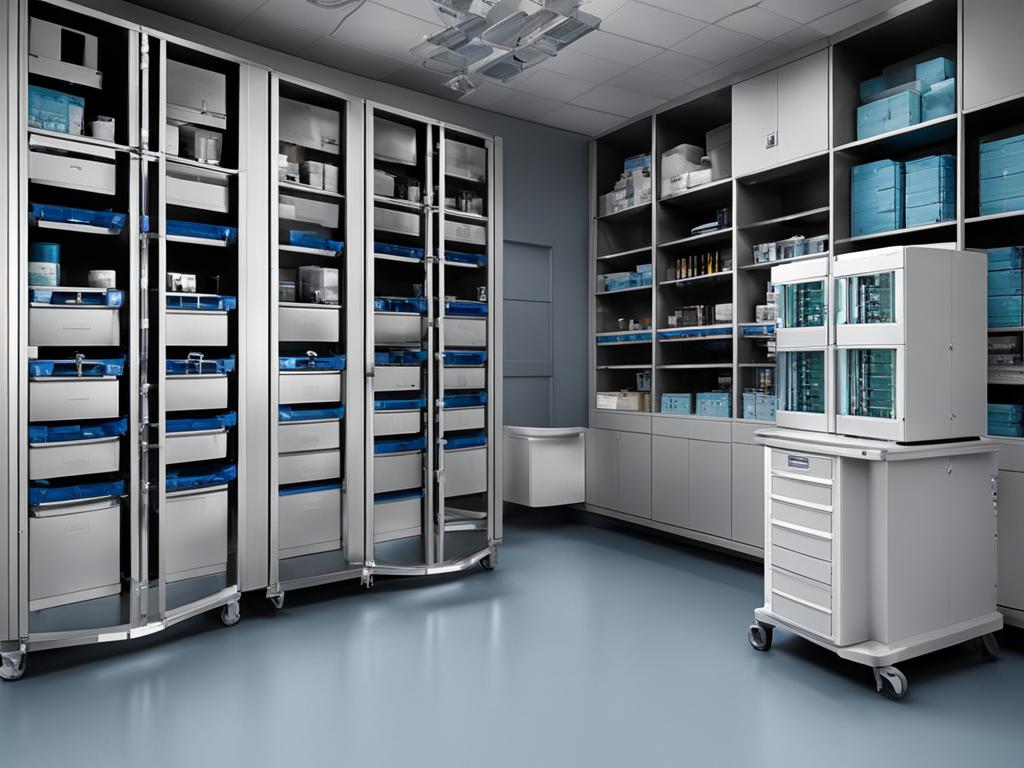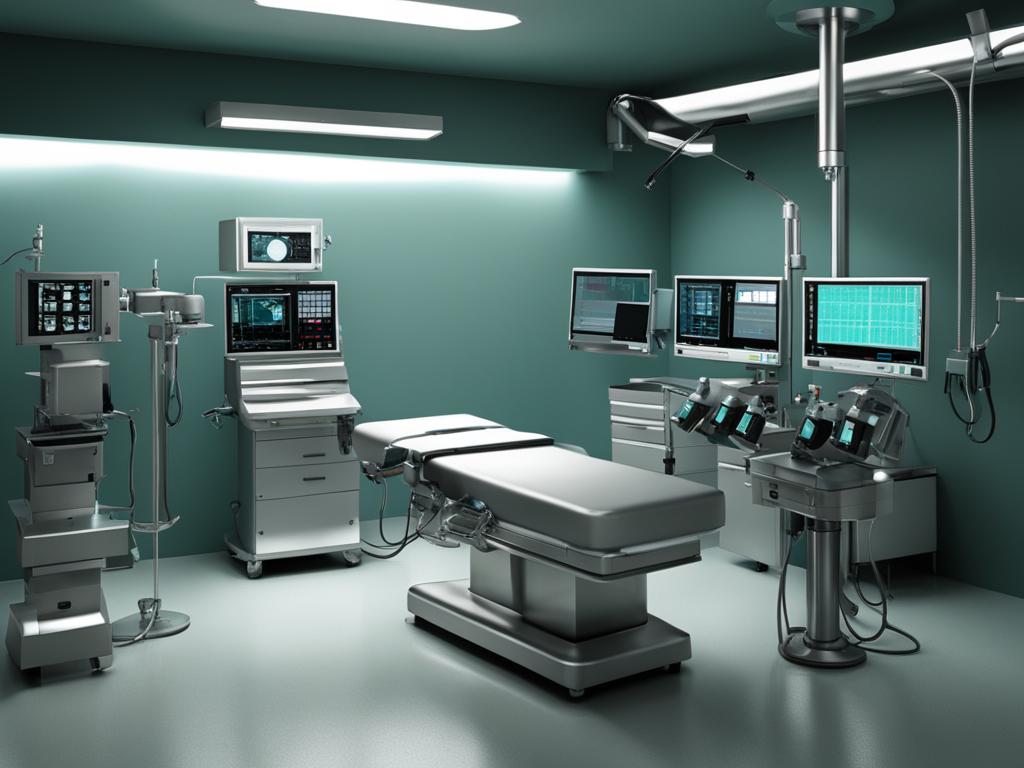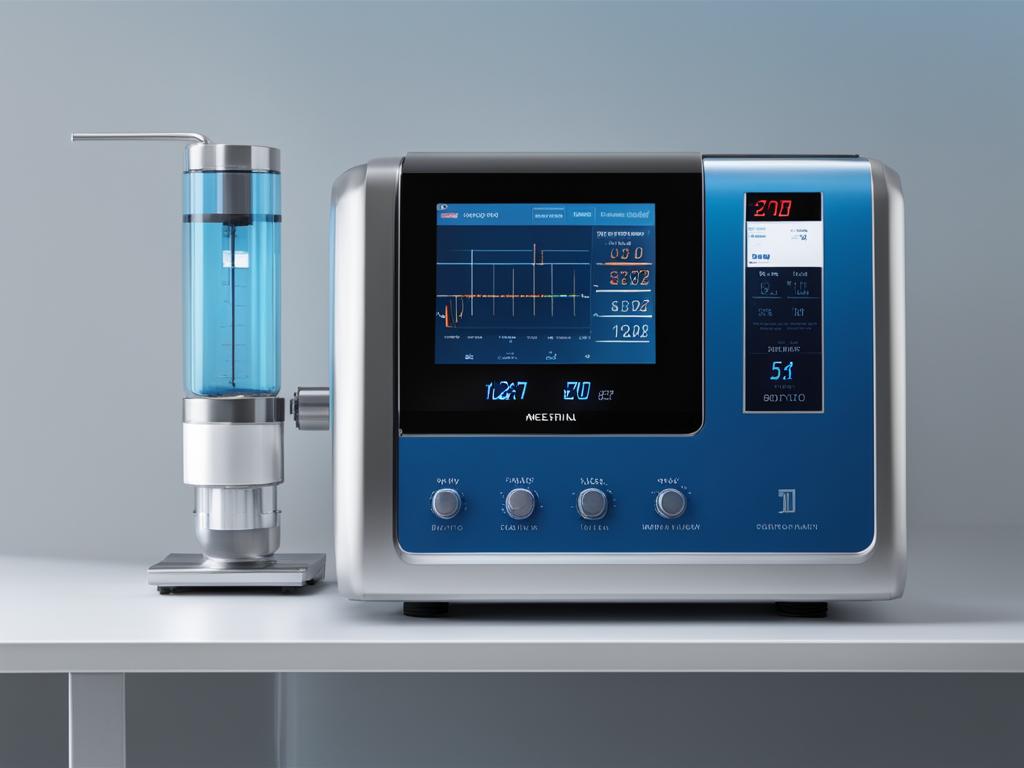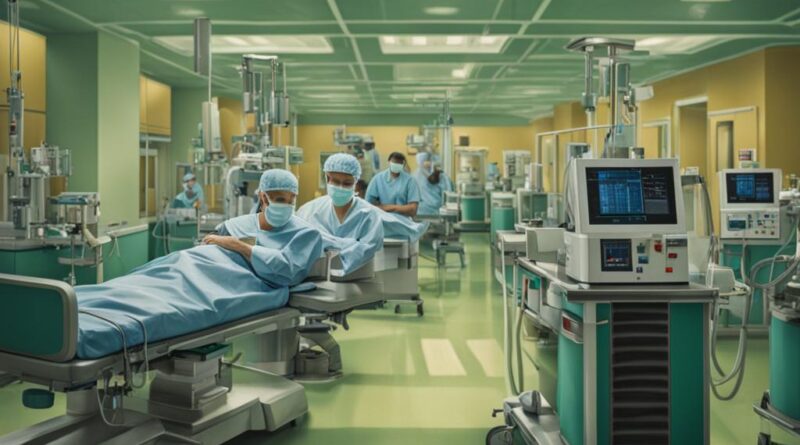Guide on How to Buy Anesthesia Machines – Learn Today
Are you in the market for an anesthesia machine? Making the right choice is essential to ensure the safety and efficiency of your medical procedures. With so many options available, it can be overwhelming to know where to begin. That’s why we’ve put together this comprehensive guide on how to buy anesthesia machines.
Key Takeaways:
- Consider specific factors when purchasing an anesthesia machine to make an informed decision.
- Choose between single circuit and double circuit ventilators based on your practice’s needs.
- Evaluate the size and mobility requirements of the machine for seamless integration.
- Ensure proper storage and organization of anesthesia machine parts.
- Prioritize safety features like backup cylinders and oxygen sensors for enhanced patient safety.
Choose Your Ventilator – Single Circuit vs Double Circuit
An important consideration when buying an anesthesia machine is the type of ventilator it uses. You can choose between a single circuit piston ventilator and a double-circuit bellows ventilator. Understanding the differences between these ventilators will help you determine which one is best suited for your practice.
A single circuit piston ventilator operates by delivering both oxygen and anesthetic gases through a single circuit. This type of ventilator is compact and lightweight, making it suitable for portable anesthesia machines. It delivers a consistent tidal volume and can be easily adjusted to accommodate different patient sizes. However, it may require more frequent refilling of anesthetic agents due to the smaller gas capacity.
On the other hand, a double-circuit bellows ventilator has separate circuits for delivering oxygen and anesthetic gases. This design provides a larger gas capacity, reducing the need for frequent refilling. The bellows system also allows for better control over tidal volume and pressure, making it ideal for precise ventilation during complex procedures. However, double-circuit ventilators tend to be larger and less portable than single circuit ventilators.
“The choice between a single circuit and a double-circuit ventilator depends on the specific needs of your practice. Consider factors such as portability, gas capacity, and ventilation control when making your decision.”
In summary, the choice between a single circuit and a double-circuit ventilator for your anesthesia machine depends on various factors. If portability and compactness are essential, a single circuit piston ventilator may be the right choice. However, if you require precise control over ventilation parameters and prefer a larger gas capacity, a double-circuit bellows ventilator would be more suitable. Evaluate your practice’s needs and consult with experts to make an informed decision.
| Ventilator Type | Pros | Cons |
|---|---|---|
| Single Circuit Piston Ventilator | Compact and lightweight | Requires more frequent refilling |
| Double-Circuit Bellows Ventilator | Larger gas capacity | Less portable |
Table 1: Comparison of Single Circuit vs Double Circuit Ventilators
Consider the Size and Mobility
When purchasing an anesthesia machine, it’s important to consider the size and mobility of the machine. These factors play a crucial role in determining whether the machine will seamlessly fit into your practice and meet your specific needs.
For facilities with limited physical space, opting for a smaller and more compact anesthesia machine is essential. Portable anesthesia machines are designed to be lightweight and easy to move, allowing for flexible placement within the facility. These machines are highly suitable for practices that require mobility, such as ambulatory surgical centers or field healthcare providers.
| Anesthesia Machine Size | Mobility Considerations |
|---|---|
| Compact and space-saving designs | Lightweight and easy to move |
| Perfect for facilities with limited space | Ideal for mobile healthcare providers |
| May have smaller storage capacity | May lack certain advanced features |
| Easy to integrate into existing setups | May require additional accessories for customization |
On the other hand, larger fixed anesthesia machines are suitable for facilities with ample space and a higher patient load. These machines typically have larger storage capacities and may offer additional advanced features. Although they may be less portable, fixed machines are often more durable and can handle heavy usage.
By carefully evaluating the size requirements and considering the mobility needs of your practice, you can ensure that the anesthesia machine you choose is a perfect fit for your facility.
Storage and Organization
Proper storage is essential when purchasing an anesthesia machine. Ensuring that your machine and its components are stored correctly not only promotes longevity but also helps maintain the functionality and performance of the equipment. Here are some considerations for anesthesia machine storage:
- Anesthesia Machine Parts: It is important to have a designated storage area for all anesthesia machine parts, including stylets, tubing, monitors, and other accessories. This ensures that these essential components are readily available and easily accessible when needed.
- Organization: Implementing an organized storage system will facilitate efficient and streamlined workflows in your practice. Consider using labeled containers or shelves to categorize and store different anesthesia machine parts. This will help save time and effort when retrieving specific items.
- Clean and Dry Environment: Anesthesia machine storage should be in a clean and dry environment to prevent the buildup of dust, dirt, or moisture. These contaminants can negatively impact the performance and functionality of the equipment over time.
- Proper Handling: Ensure that anesthesia machine parts are handled with care during storage. Avoid dropping or mishandling delicate components to prevent damage. Storing items in padded containers or protective cases can provide an extra layer of security.
“Proper storage of anesthesia machine parts is crucial to maintain the equipment’s functionality and performance. By implementing an organized storage system and ensuring a clean and dry environment, healthcare providers can optimize the lifespan of their anesthesia machines.”
Remember to regularly inspect and clean your anesthesia machine and its components to ensure they are in optimal condition. By prioritizing storage and organization, you can safeguard your investment and ensure that your anesthesia machine is always ready for use.

| Storage Considerations | Actions |
|---|---|
| Designated Storage Area | Create a specific area to store anesthesia machine parts |
| Organization | Implement an organized system with labeled containers or shelves |
| Clean and Dry Environment | Ensure storage area is free from dust, dirt, and moisture |
| Proper Handling | Handle anesthesia machine parts with care to prevent damage |
By following these storage guidelines, healthcare providers can maintain the performance and functionality of their anesthesia machines, ultimately ensuring the safety and well-being of their patients.
Safety Features to Prioritize
When purchasing an anesthesia machine, one of the key considerations should be the safety features it offers. These features play a crucial role in ensuring the well-being and security of both patients and healthcare providers during procedures. Here are some safety features that you should prioritize when choosing an anesthesia machine:
- Backup Oxygen Cylinders: An anesthesia machine with backup oxygen cylinders provides a fail-safe mechanism in case of a main oxygen supply failure. This ensures uninterrupted oxygen flow to the patient, preventing any potential harm due to oxygen deprivation.
- Oxygen Sensors: Oxygen sensors are essential components of an anesthesia machine as they continuously monitor the oxygen concentration delivered to the patient. These sensors provide real-time feedback to the anesthesiologist, allowing them to make adjustments and maintain optimal oxygen levels for safe anesthesia administration.
By prioritizing these safety features, you can enhance patient safety and minimize risks associated with anesthesia administration. It is crucial to ensure that your chosen anesthesia machine meets the highest safety standards and compliance requirements.
Example Safety Feature Checklist
| Safety Feature | Description |
|---|---|
| Backup Oxygen Cylinders | Presence of backup oxygen cylinders in case of main oxygen supply failure. |
| Oxygen Sensors | Continuous monitoring of oxygen concentration delivered to the patient. |
| Positive Pressure Relief Valve | Release of excess pressure from the anesthesia circuit to prevent barotrauma. |
| Low Oxygen Alarm | Alerts the anesthesiologist in case of a drop in the oxygen concentration below a specified threshold. |
This checklist provides a comprehensive overview of some essential safety features that anesthesia machines should possess. It serves as a valuable reference tool when evaluating different models and ensures that you make an informed decision regarding patient safety.
Choosing Between New and Refurbished Machines
When it comes to purchasing an anesthesia machine, one of the crucial decisions you’ll need to make is whether to buy a new machine or opt for a refurbished one. Each option has its own set of pros and cons, so it’s important to weigh them carefully before making a decision.
New Anesthesia Machines:
Investing in a brand new anesthesia machine offers several advantages. Firstly, new machines are more likely to come with the latest technology and advanced features, ensuring that you have access to cutting-edge equipment. Additionally, new machines often come with warranties, providing you with peace of mind knowing that any potential issues will be covered. However, it’s important to note that new machines generally come with a higher price tag compared to refurbished ones.
Refurbished Anesthesia Machines:
Opting for a refurbished anesthesia machine can be a cost-effective choice, especially if you have budget constraints. Refurbished machines have undergone thorough inspection and maintenance to ensure they are in proper working condition. While they may not have the same level of technology as new machines, they can still provide reliable performance. However, it’s important to carefully review the refurbishment process and quality standards of the supplier to ensure that you are getting a machine that meets your needs.
When deciding between new and refurbished anesthesia machines, it’s crucial to consider factors such as your budget, the specific needs of your practice, and the level of technology you require. By carefully evaluating these factors, you can make an informed decision that aligns with your goals and priorities.
| New Anesthesia Machines | Refurbished Anesthesia Machines | |
|---|---|---|
| Advantages |
|
|
| Disadvantages |
|
|
Integrated Systems for Full Operating Rooms
Integrated anesthesia systems are a sophisticated solution for full operating rooms with demanding surgical schedules. These advanced systems offer a range of features designed to enhance patient care and streamline workflow. By integrating multiple components into one cohesive unit, these systems provide convenience, efficiency, and improved patient safety.
Enhanced Ventilation Control
One key feature of integrated anesthesia systems is enhanced ventilation control. With volume and pressure control capabilities, these systems allow precise adjustment of the delivery of anesthesia gases to meet the unique needs of each patient. This level of control ensures optimal patient ventilation and reduces the risk of complications during surgery.
Multiple Vaporizer Chambers
Integrated anesthesia systems also offer the advantage of multiple vaporizer chambers. This allows for the use of different anesthetic agents simultaneously, eliminating the need for manual switching and increasing efficiency. The ability to quickly and easily switch between agents enhances flexibility and gives anesthesiologists greater control over patient care.
Integrated Monitoring
Another notable feature of integrated anesthesia systems is the integration of monitoring capabilities. These systems can display vital signs, anesthesia agent concentrations, and other relevant patient data in real-time, directly on the system’s interface. This integration eliminates the need for separate monitoring devices and enhances data accessibility, enabling healthcare professionals to make informed decisions quickly and efficiently.
Overall, integrated anesthesia systems provide a comprehensive solution for full operating rooms. With their advanced features such as enhanced ventilation control, multiple vaporizer chambers, and integrated monitoring, these systems offer improved patient care, workflow efficiency, and data accessibility. Consider the specific needs of your facility when choosing an integrated anesthesia system to ensure seamless integration and enhanced patient safety.

Compatibility with Existing Equipment
Ensuring compatibility with your existing equipment is a crucial factor when purchasing an anesthesia machine. By checking the vaporizer mounting options, gas delivery system, and other components, you can ensure a seamless integration and operation within your facility.
When it comes to vaporizer mounting options, different machines may have varying compatibility. It’s important to verify if your chosen machine supports the specific vaporizers you currently use or plan to use in the future. This will ensure that you can utilize your existing inventory and avoid the need for additional purchases.
Another aspect to consider is the compatibility of the gas delivery system. Check if the anesthesia machine is compatible with the type of gas sources available in your facility. Whether it’s oxygen, nitrous oxide, or a combination of gases, it’s important to ensure that the machine can accommodate your specific gas requirements.
Taking the time to assess compatibility with your existing equipment will help you avoid any compatibility issues or the need for additional modifications. By selecting a machine that seamlessly integrates with your current setup, you can enhance efficiency and reduce the risk of operational disruptions.
| Vaporizer Mounting Options | Gas Delivery System |
|---|---|
| Suitability for existing vaporizers | Compatibility with oxygen, nitrous oxide, or other gases |
| Ability to utilize existing inventory | Accommodation of specific gas requirements |
| Prevention of additional purchases | Avoidance of compatibility issues |
| Seamless integration with current setup | Enhanced efficiency and operational stability |
Considerations for Compatibility:
- Verify if the anesthesia machine supports your existing vaporizers.
- Check if the machine is compatible with the gas sources available in your facility.
- Assess the ability to utilize your current inventory and prevent additional purchases.
- Ensure seamless integration with your current setup for enhanced operational efficiency.
Evaluating the Investment
When purchasing an anesthesia machine, it is essential to evaluate the investment value to make a sound financial decision. Consider factors such as the initial purchase price, expected maintenance costs, and end-of-life considerations.
Anesthesia Machine Investment:
| Factors | Considerations |
|---|---|
| Initial Purchase Price | Compare prices from different suppliers and manufacturers to ensure you are getting the best value for your money. |
| Maintenance Costs | Take into account the estimated cost of regular servicing, repairs, and replacement parts over the machine’s lifespan. |
| End-of-Life Considerations | Look into the expected lifespan of the machine and determine if third-party maintenance services can support it beyond that period. |
By carefully evaluating these investment factors, you can make a well-informed decision that aligns with your budget and long-term needs. Don’t forget to consider the expected return on investment in terms of improved patient care and efficiency in your practice.
Anesthesia Machine Low Flow Capabilities: Cost-Effective Anesthesia Options
When considering the purchase of an anesthesia machine, it is important to explore its low flow capabilities as a cost-effective anesthesia option. Anesthesia machines with low flow capabilities allow for the reduction of expensive anesthesia agents while ensuring a steady supply of fresh gas to patients. By utilizing low flow techniques, healthcare facilities can experience significant cost savings in the long run.
Low flow anesthesia involves delivering lower gas flow rates to patients during surgical procedures. This technique promotes the conservation of anesthesia agents and reduces the consumption of costly gases. By optimizing the delivery of anesthetic agents based on the patient’s needs, low flow anesthesia allows for efficient utilization and cost savings without compromising patient safety.
Furthermore, anesthesia machines with low flow capabilities contribute to environmental sustainability by minimizing the waste of gases. This aligns with the growing trend in healthcare towards eco-friendly practices. By investing in an anesthesia machine with low flow capabilities, healthcare facilities can simultaneously reduce their environmental impact and achieve significant cost savings.

Benefits of Anesthesia Machine Low Flow Capabilities:
- Cost savings through reduced consumption of expensive anesthesia agents
- Improved environmental sustainability by minimizing gas waste
- Efficient utilization of anesthesia agents without compromising patient safety
- Long-term financial benefits for healthcare facilities
Low flow anesthesia: “By optimizing the delivery of anesthetic agents based on the patient’s needs, low flow anesthesia allows for efficient utilization and cost savings without compromising patient safety.”
By considering the low flow capabilities of an anesthesia machine, healthcare facilities can implement cost-effective anesthesia options that benefit both their finances and the environment. This strategic approach to anesthesia delivery ensures optimal patient care while maximizing resource utilization. Incorporating low flow techniques into anesthesia practices is a valuable investment for healthcare facilities looking to achieve long-term cost savings and sustainable healthcare practices.
Conclusion
When it comes to buying anesthesia machines, making an informed purchase decision is vital. By considering factors such as the type of ventilator, size and mobility, safety features, compatibility, investment value, and low flow capabilities, you can ensure that you choose the right machine for your facility.
Consulting with experts in the field and evaluating the specific needs of your practice will help you make the best possible decision. Remember to prioritize patient safety by selecting a machine with essential safety features such as backup oxygen cylinders and oxygen sensors.
Whether you opt for a new machine or a refurbished one, carefully weigh the pros and cons before finalizing your choice. Additionally, assess the compatibility of the anesthesia machine with your existing equipment to facilitate seamless integration and operation.
By taking all these factors into account and conducting thorough research, you can confidently navigate the process of buying anesthesia machines and make an informed purchase decision that aligns with the needs of your practice.
FAQ
What factors should I consider when purchasing an anesthesia machine?
Factors to consider include the type of ventilator, size and mobility requirements, storage needs, safety features, compatibility with existing equipment, investment value, and low flow capabilities.
What is the difference between a single circuit and a double circuit ventilator?
A single circuit ventilator uses a piston, while a double circuit ventilator uses bellows. The choice depends on your specific needs and preferences.
What should I consider regarding the size and mobility of the anesthesia machine?
You should evaluate the physical space available in your facility and determine if a larger fixed machine or a smaller portable machine would be more suitable.
How can I ensure proper storage and organization of the anesthesia machine?
Consider the storage needs for anesthesia machine parts such as stylets, tubing, and monitors. Having a designated storage area will help keep equipment readily available.
What safety features should I prioritize in an anesthesia machine?
Look for features such as backup oxygen or nitrous cylinders, oxygen sensors, and vaporizer ports for different patient types to enhance patient safety.
Should I buy a new or refurbished anesthesia machine?
This decision depends on your budget constraints. New machines may have a longer lifespan but come with a higher price tag, while refurbished machines can be a cost-effective option.
Are integrated anesthesia systems suitable for my facility?
Integrated systems are designed for full operating rooms with heavy surgical schedules and offer advanced features. Consider if these features align with your facility’s needs.
How can I ensure compatibility with my existing equipment?
Check if the vaporizer mounting options, gas delivery system, and other components align with your current setup to facilitate seamless integration and operation.
What factors should I consider when evaluating the investment value of an anesthesia machine?
Factors such as initial purchase price, expected maintenance costs, potential equipment problems, end-of-life date, and third-party maintenance services should be assessed.
What are the benefits of anesthesia machines with low flow capabilities?
Anesthesia machines with low flow capabilities can help reduce the need for expensive anesthesia agents and maintain a steady supply of fresh gas, leading to long-term cost savings.
How can I make an informed purchase decision when buying anesthesia machines?
By considering factors such as ventilator type, size and mobility, storage and organization, safety features, compatibility, investment value, and low flow capabilities, you can choose the right anesthesia machine for your facility. Consult with experts and evaluate the specific needs of your practice for the best outcome.

